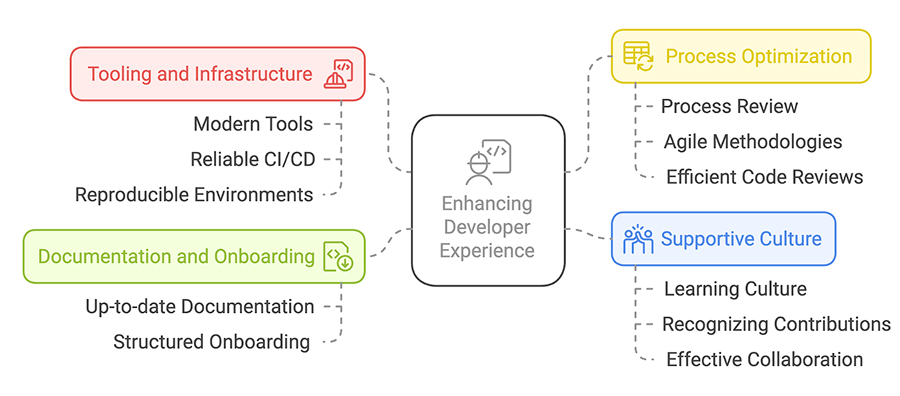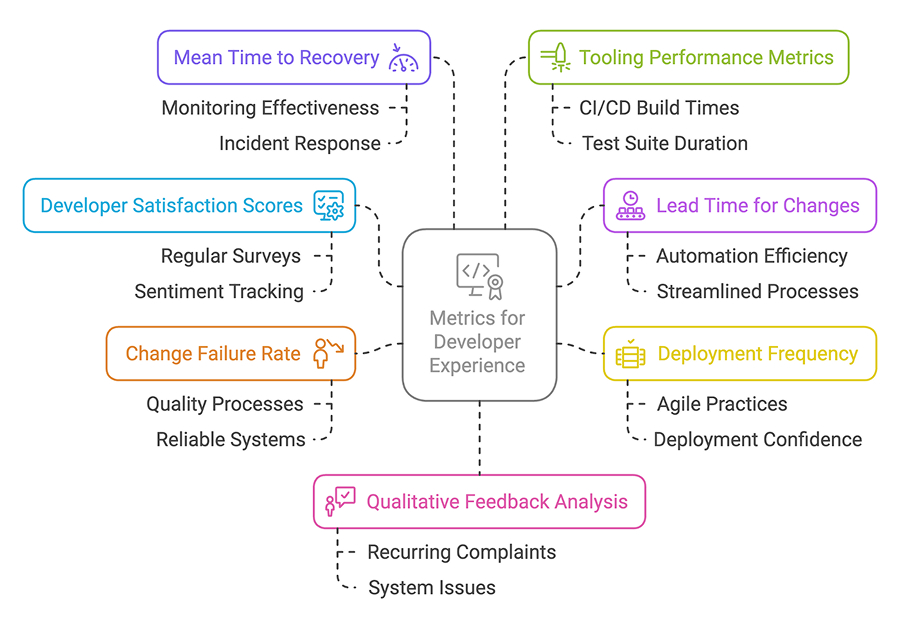
How well engineers can build software dictates a tech company’s success. Beyond market strategy, the processes they follow and the overall environment fundamentally shape results. We call this entire picture the developer experience (DX). Getting DX right isn’t just a perk; it’s a core factor driving innovation speed, software quality, and whether your best engineers stick around in the company.
A survey by Stripe found that developers spend over 17 hours per week on average on maintenance tasks like debugging and refactoring, leaving only about 13.5 hours for building new features.
This article digs into what makes a developer experience truly effective. We’ll explore concrete strategies to smooth out common development hurdles and discuss how you can actually track whether your efforts are making a difference.
What Is Developer Experience

At its essence, developer experience is a combination of all that affects a developer’s ability to get their work done effectively and with minimal frustration. It is a broad topic that covers some core areas like:
- The tools we use: This includes everything from IDEs to CI/CD pipelines, testing frameworks, and the dashboards used for monitoring applications. Are they fast, reliable, and integrated?
- Our daily workflows: How does code get reviewed? What are the steps for deployment? How are bugs tracked and prioritized? How do different teams coordinate their work? Efficient processes are the key here.
- The underlying infrastructure: Developers rely on stable and performant development environments, reliable testing infrastructure, and robust production systems. Instability here causes major disruptions.
- Access to information: Engineers should be able to quickly find accurate API documentation. Architectural decisions need to be clearly recorded and accessible. New hires should find it easy to understand the systems and processes.
- Team and company culture: How easily can developers collaborate? Is there a sense of psychological safety allowing people to ask questions or raise concerns? Are there opportunities to learn and grow? Is feedback encouraged and acted upon?
When DX is poor, the signs are obvious:
- Slow builds
- Flaky tests
- Complex deployment procedures
- Outdated or missing documentation
- Constant context switching between disjointed tools.
This is not only frustrating but also wastes a lot of time, lowers morale, reduces code quality, delays feature delivery, and makes it difficult to retain good developers.
On the other hand, good DX often goes unnoticed. It quietly removes obstacles, letting engineers focus on solving real problems and delivering value faster.
Recognizing the strategic importance of DX, some organizations establish a dedicated developer experience team. This specialized group acts as internal product managers, focusing solely on optimizing the engineering environment. They proactively identify friction points, evaluate and implement better tooling, streamline processes, and improve documentation, treating their fellow developers as their primary customers.
Best Practices to Improve Developer Experience

To achieve real improvements in DX, you need to look beyond singular fixes. You need an end-to-end solution that accommodates the interconnectedness of tools, processes, and culture. Here are the leading practices proven to improve developer experience:
1. Get your tooling and infrastructure right
Engineers interact with infrastructures daily, which forms the foundation of their experience. Slow, unreliable, or poorly integrated tools are a constant source of drag.
Adopt modern, integrated tools:
- Provide access to capable IDEs with strong support for code completion, debugging, and refactoring.
- Consistency allows flexibility for specific team needs or roles.
- The key is ensuring seamless integration between core tools, version control, issue tracking, CI/CD, and communication platforms to reduce friction and minimize context switching across teams.
Ensure reliable and fast CI/CD pipelines:
- Automation for builds, tests, and deployments should be rock-solid and fast. Waiting minutes (or longer) for feedback kills momentum.
- Invest in optimizing these pipelines through caching, parallelization, and efficient dependency management.
- Fast, reliable feedback loops are essential when building a good DX.
Provide easily reproducible development environments:
- Use containerization (like Docker) or similar techniques to ensure development environments closely mirror testing and production.
- This drastically reduces “it works on my machine” issues and simplifies debugging.
- Automate the setup process so developers can get running quickly.
2. Prioritize documentation and onboarding
Accessible, accurate information is critical for getting new hires productive quickly and for enabling existing engineers to navigate complex systems.
Maintain up-to-date, comprehensive documentation:
- Treat documentation as a living part of your system, requiring updates alongside code changes.
- This includes API references, architectural diagrams, operational runbooks, and setup guides.
- Make it easily discoverable via a central system with good search capabilities.
Implement structured onboarding programs:
- Don’t leave new developers to fend for themselves.
- Provide a clear plan, including environment setup and introductions to key systems and people.
- Assigning well-defined starter tasks builds confidence and familiarity.
- Following a buddy system significantly accelerates their time to contribute.
3. Streamline and optimize processes
Even with great tools, cumbersome or bureaucratic workflows will hinder progress. Regularly examine how work gets done.
Regularly review and refine development processes:
- Continuously gather feedback from engineers regarding pain points in processes like code review, branching techniques, or release management.
- Use retrospectives or specific conversations to identify areas with bottlenecks or potential for enhancement.
Encourage agile methodologies for adaptability:
- Focus on the principles: iterative development, frequent feedback loops, and the ability to adapt to change.
- This helps teams stay aligned and adjust course efficiently.
- Automate repetitive process steps wherever possible to free up human effort.
Make code reviews efficient and constructive:
- Establish clear guidelines focusing on important aspects (logic, architecture, potential issues) rather than trivial style nits (which linters should catch).
- Aim for reasonable turnaround times so reviews don’t become a major block.
- Utilize tooling that integrates reviews smoothly.
4. Cultivate a supportive culture and environment
The underlying team and company culture profoundly shape the day-to-day developer experience. A positive environment is crucial.
Promote a culture of learning and continuous improvement:
- Encourage knowledge sharing through tech talks, internal blogs, pair programming, or dedicated learning time.
- Support professional development. It creates psychological safety in which engineers can question things, experiment, and even fail without being criticized.
Recognize and reward diverse contributions:
- In addition to feature delivery, acknowledge the efforts that improve the ecosystem for everyone, such as enhancing tools, writing great documents, and mentoring others. This reinforces valuable behaviors.
Foster effective collaboration:
- Break down silos.
- Encourage communication and cooperation between teams, especially where dependencies exist.
- Provide tools that facilitate easy communication and knowledge sharing.
Metrics for Developer Experience

To tackle DX in an organized way, you need to know how developers perceive their environment and measure the impact of change. Guessing won’t cut it. You have to understand how developers feel about their tools, processes, and environment and track whether your efforts are actually making things better.
Start by making it easy for developers to share feedback. This could be:
- A dedicated Slack channel for DX suggestions
- Lightweight pulse surveys
- Feedback prompts built into internal tools
Use linters, static code analysis, and rapid automated tests to provide instant feedback on code quality at development time. While DX has qualitative aspects, measurement provides quantitative measures of progress and helps justify expenditure.
1. Developer satisfaction scores:
Use regular, brief surveys (perhaps adapted Net Promoter Score or targeted questions) to gauge sentiment about specific tools, processes, or overall work environment. Track these trends over time.
2. Lead time for changes:
Measure the typical time from code commit to that code running successfully in production. Shorter lead times often indicate efficient automation and streamlined processes (a core DORA metric).
3. Deployment frequency:
Track how often your team successfully releases to production. Higher frequency generally correlates with smaller batch sizes, agile practices, and confidence in the deployment pipeline (a core DORA metric).
4. Change failure rate:
Calculate the percentage of deployments that cause a failure in production (requiring a hotfix, rollback, etc.). Lower rates signal higher quality and more reliable processes (a core DORA metric).
5. Mean time to recovery (MTTR):
Measure the average time it takes to restore service after a production failure. This reflects the effectiveness of monitoring, alerting, and incident response (a core DORA metric).
6. Tooling performance metrics:
Track concrete numbers like average CI/CD build times, test suite execution duration, or time to provision a new development environment. Reducing these directly boosts daily productivity.
7. Qualitative feedback analysis:
Systematically analyze the themes emerging from surveys and feedback channels. Are there recurring complaints about specific systems or processes? This context helps explain the ‘why’ behind your metrics and guides smarter decisions.
Wrapping Up
Thoughtful investment in developer experience is a prerequisite for any technology business looking to have sustained success. The question becomes, what are you going to do about it? Think about last week:
- Where did you waste time?
- What actually angered you or your teammates?
- Waiting for a build?
- Fighting against a flaky test environment?
- Tussling with undocumented code?
Improving the developer experience starts right there, identifying those specific, tangible roadblocks. It’s about engineers pointing out the friction and pushing, even for small fixes, because less time spent fighting the system means more time actually building cool stuff, shipping faster, and enjoying the work more.


